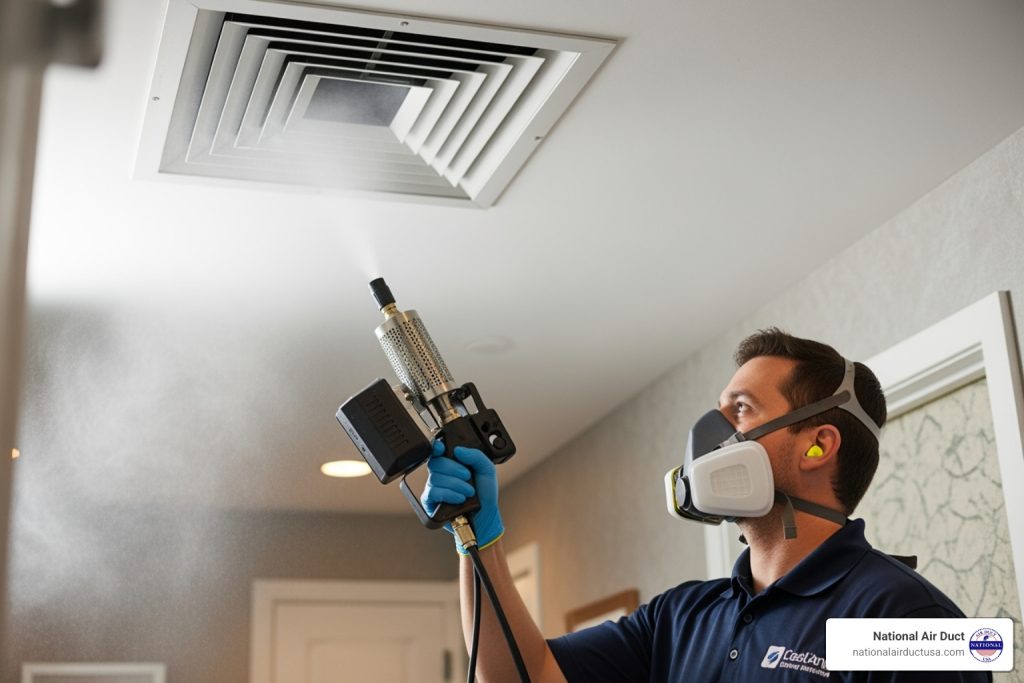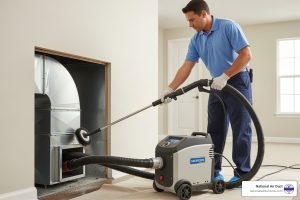What Is Air Duct Disinfectant and Why Does It Matter?
Air duct disinfectant is a specialized antimicrobial solution designed to eliminate bacteria, viruses, mold, and other harmful microorganisms from your HVAC system’s ductwork. These EPA-registered products are applied through professional fogging or misting techniques to sanitize surfaces that regular cleaning alone cannot reach.
Quick Answer for Air Duct Disinfectant Buyers:
- Sanitizers kill 99.9% of bacteria on surfaces
- Disinfectants eliminate specific fungi, viruses, and bacteria
- Common types: Thymol (plant-based), hydrogen peroxide, quaternary ammonium compounds
- Application time: 3-5 seconds per duct via professional fogging
- Protection duration: Up to 6 months per application
- Safety requirement: 2-8 hours for fumes to clear before re-entry
Your home’s air quality matters more than you might think. According to the EPA, indoor air pollutants are often 2 to 5 times higher than outdoor levels – and in some cases can exceed 100 times outdoor pollution levels.
Every day, your HVAC system recirculates air throughout your home an average of 5-7 times, pulling in dust, dander, chemicals, and biological contaminants. When these pollutants accumulate in your ductwork, they create breeding grounds for mold, bacteria, and other microorganisms that get distributed throughout your living space.
Air duct disinfection becomes especially important after water damage, pest infestations, or when visible mold growth is present. It’s not routine maintenance – it’s a targeted solution for specific contamination issues.
The process involves applying EPA-registered antimicrobial products directly into your ductwork after thorough cleaning. Professional technicians use specialized fogging equipment to ensure complete coverage while following strict safety protocols to protect your family.
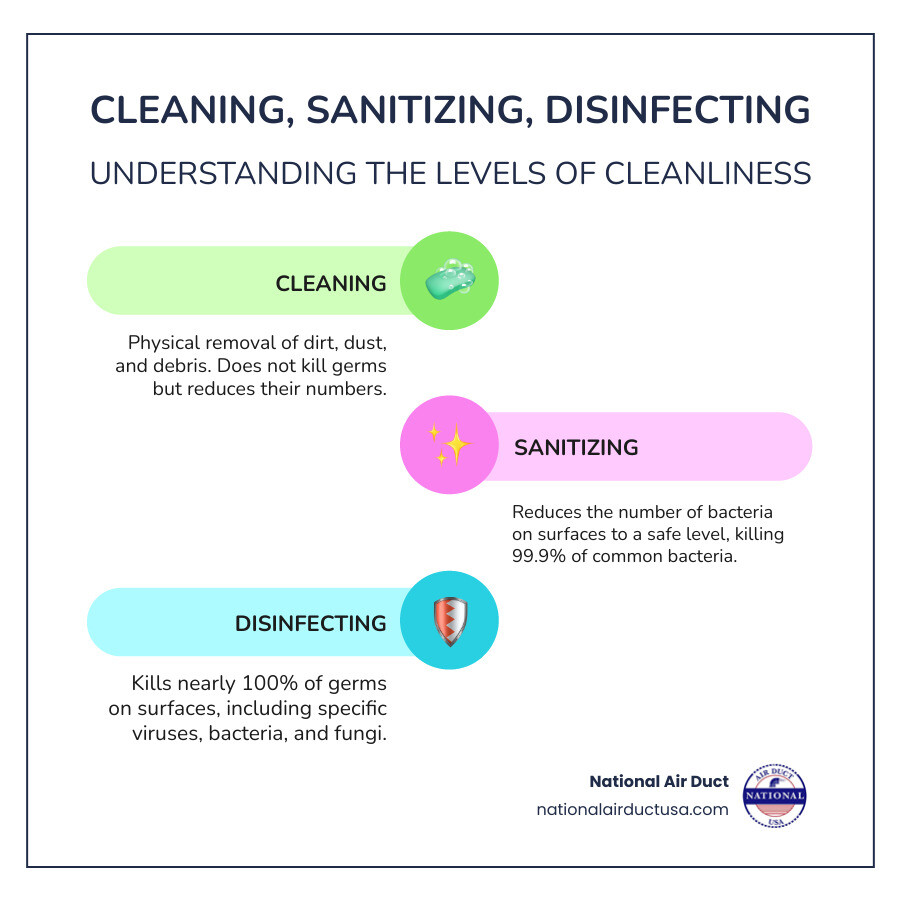
Understanding Your Air Duct Disinfectant Options
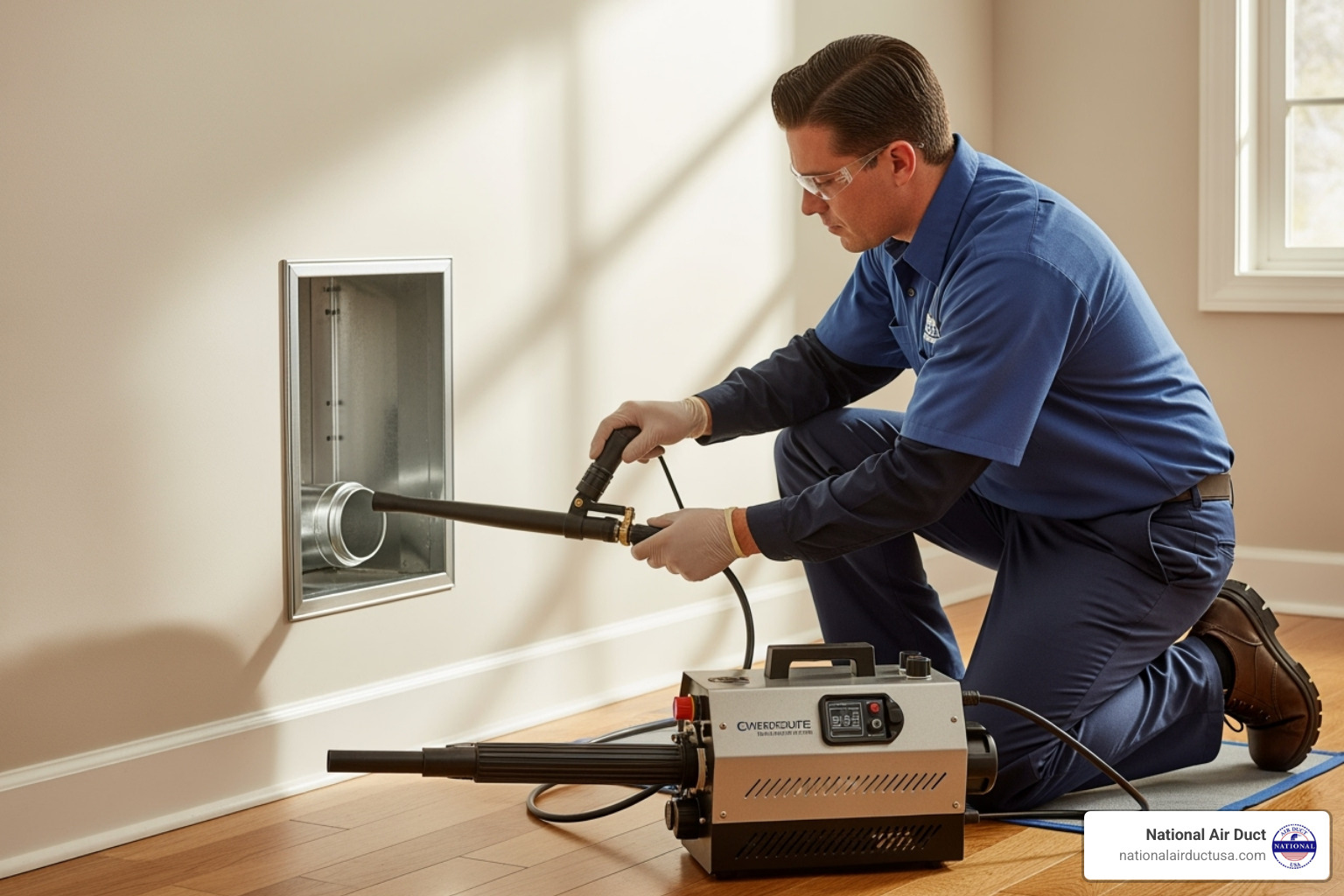
Choosing the right air duct disinfectant can feel overwhelming with so many options out there. But here’s the thing – these aren’t your typical household cleaners from the grocery store. We’re talking about specialized, EPA-registered solutions designed specifically for HVAC systems.
Think of it this way: your ductwork is like the circulatory system of your home. You wouldn’t put just any substance into your bloodstream, right? The same logic applies here. Professional air duct disinfectants are formulated to tackle microscopic invaders while keeping your family safe and ensuring your system runs smoothly.
These products focus on three main goals: safety, efficacy, and odor control. They need to eliminate harmful microorganisms without damaging your ducts or putting your health at risk. Plus, nobody wants their home smelling like a hospital for days after treatment.
Types of Disinfectants Used in HVAC Systems
Let’s break down what’s actually going into your ducts. Each type of disinfectant brings something different to the table, and understanding these differences helps explain why professionals choose specific products for specific situations.
Plant-based disinfectants like those containing thymol (derived from thyme oil) are becoming increasingly popular. Products like Decon 30 and Duct Aid fall into this category. What makes them appealing? They typically have the EPA’s lowest toxicity rating and can kill 99.9% of germs in just 30 seconds. Many are even safe for use in occupied spaces, which means less disruption to your daily routine.
Quaternary ammonium compounds – or “quats” as we call them – are synthetic workhorses. They’re effective against bacteria, fungi, and viruses, offering broad-spectrum protection. While potent, they require careful application according to product labels to ensure safety.
Hydrogen peroxide-based solutions like Decon7 are powerful oxidizers that break down a wide range of microorganisms, including stubborn biofilms. The EPA often lists these on their safer ingredient list, and they’re known for being less corrosive to your ductwork.
Chlorine dioxide products such as Bio-Fresh cd and EnviroCON work differently – they eliminate odors at their source rather than just masking them. Bio-Fresh cd is particularly interesting because it’s EPA-registered as a bacteriostat and fungistat that can be applied in occupied areas, though it’s typically restricted to HVAC professionals.
Phenol-based disinfectants like Sporocidin are the heavy hitters. They can kill viruses in five minutes and achieve nearly 100% effectiveness against bacteria and fungi within ten minutes. Due to their potency, they require strict safety protocols and proper ventilation.
Here’s how these options stack up:
| Disinfectant Type | Kill Time | Safety Profile | Best For |
|---|---|---|---|
| Plant-based (Thymol) | 30 seconds | Low toxicity | General disinfection, residential use |
| Quaternary Ammonium | Varies | Moderate | Broad-spectrum microbial control |
| Hydrogen Peroxide | Varies | EPA safer list | Biofilms, mold, general disinfection |
| Chlorine Dioxide | Varies | Low (when used properly) | Odor elimination, professional use |
| Phenol-based | 5-10 minutes | Requires careful handling | Severe contamination, high-level disinfection |
Key Considerations for Choosing an Air Duct Disinfectant
When we’re selecting an air duct disinfectant for your home, we don’t just grab whatever’s available. Several critical factors guide our decision, and understanding these can help you feel confident about the process.
EPA registration is absolutely non-negotiable. Any product going into your HVAC system must have EPA approval. This isn’t just a nice-to-have – it’s federal law under FIFRA (Federal Insecticide, Fungicide and Rodenticide Act). Using unregistered products or using registered products incorrectly is illegal and potentially dangerous.
We prioritize products with no known adverse effects on humans and pets. Look for low toxicity ratings and formulations approved for occupied spaces. Your family’s health comes first, always.
Material compatibility is huge and often overlooked. Your ductwork material determines which products we can safely use. Bare sheet metal ducts can handle a wider range of disinfectants, but fiberglass ducts are trickier. In fact, if fiberglass ductwork shows visible mold or has been wet, industry recommendations often suggest replacement rather than treatment, since no EPA-registered biocides exist for porous materials like fiberglass.
Odor profile and residue matter too. Some disinfectants leave strong chemical smells or sticky residues. We prefer products that dissipate quickly, leaving either a neutral scent or a light, pleasant aroma that fades within an hour or so.
The toxicity rating of any product we use is carefully evaluated. We want maximum effectiveness with minimum risk. This is especially important if you have family members with chemical sensitivities or respiratory conditions.
For more detailed information about our specific approach and methods, check out our comprehensive guide on how to disinfect air ducts.
The bottom line? Choosing the right disinfectant isn’t just about killing germs – it’s about doing so safely, effectively, and in a way that’s compatible with your specific HVAC system.
The Disinfection Process: How Professionals Apply Sanitizers Safely
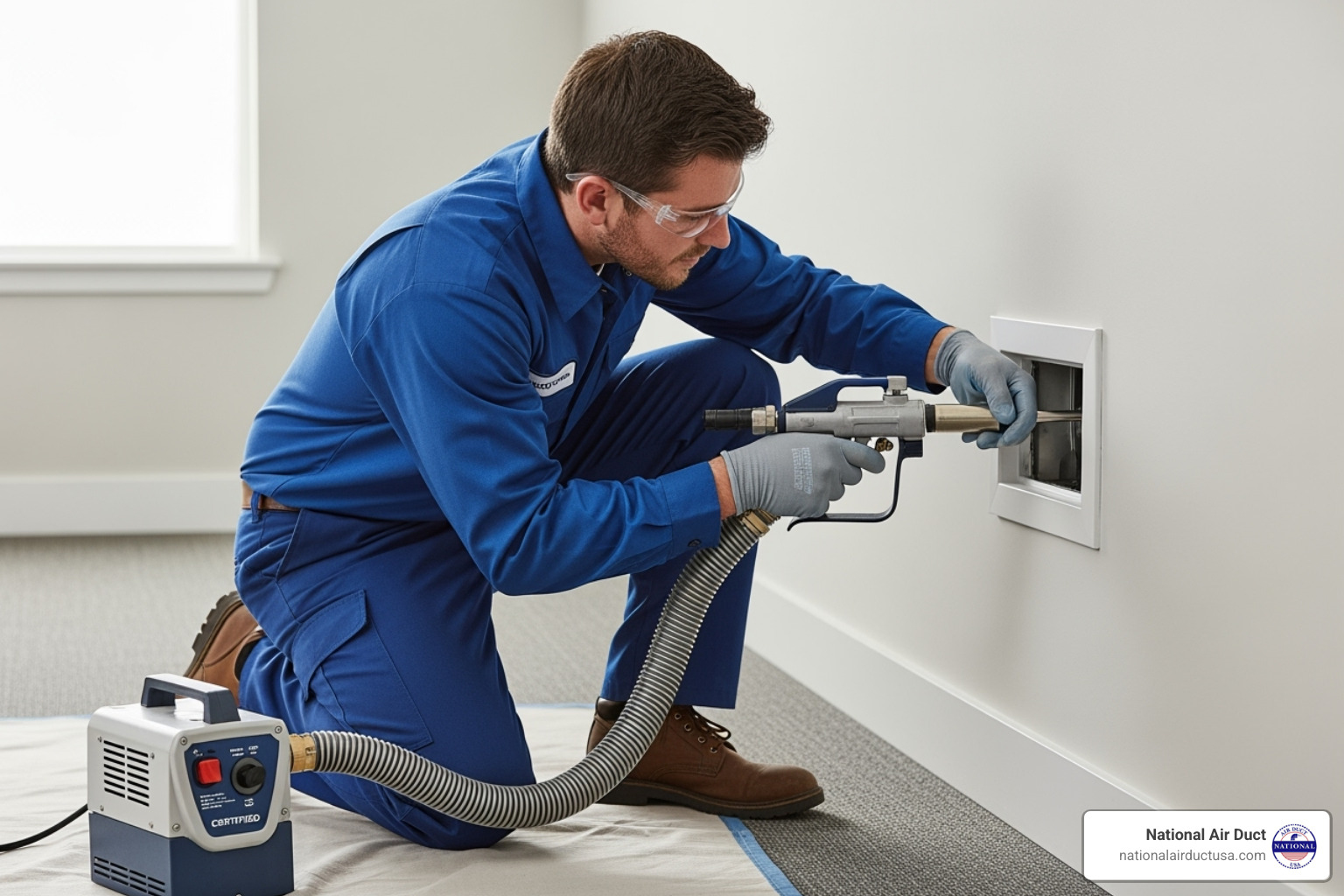
Think of air duct disinfectant application like preparing a canvas before painting a masterpiece. You wouldn’t paint over dirt and grime, and we certainly don’t spray disinfectant over dusty, debris-filled ducts. The magic happens in the preparation, and that’s where our expertise really shines.
Air duct cleaning versus disinfection might sound like the same thing, but they’re actually two very different processes. Cleaning is all about source removal – physically removing the dust, debris, allergens, and contaminants that have built up in your system over time. Disinfection comes after, targeting the microscopic invaders that cleaning alone can’t eliminate.
Once your ducts are thoroughly cleaned, we move into the disinfection phase using specialized fogging or misting techniques. Picture a fine, even cloud of disinfectant traveling through your entire duct system, reaching every surface that regular cleaning tools simply can’t access. The application time is surprisingly quick – usually just 3-5 seconds per duct – but timing is everything.
The real key is something we call dwell time. That’s how long the disinfectant needs to sit on surfaces to effectively kill bacteria, viruses, and mold. Think of it like letting dish soap sit on a greasy pan – it needs time to do its work. During this process, proper ventilation requirements are crucial, and you’ll need to plan for fume dissipation time of about 2-8 hours before your home is ready for you to return.
The Professional Application of an Air Duct Disinfectant
Our approach to applying air duct disinfectant follows a careful sequence that ensures both safety and effectiveness. It all starts with pre-cleaning the system – and we mean the entire system, not just the ducts themselves.
We begin with comprehensive Blower Cleaning and Coil Cleaning because these components are often the dirtiest parts of your HVAC system. Our truck-mounted vacuum systems pack serious power – we’re talking 12,000 CFM compared to those portable units that max out at 5,000 CFM. That extra suction power makes all the difference in removing years of accumulated debris.
After the thorough cleaning, we prepare your system by sealing registers strategically. This isn’t about blocking airflow – it’s about controlling exactly where the disinfectant goes. Next, we get your HVAC fan running because we need that air movement to carry the disinfectant throughout your entire duct network.
The actual application involves inserting specialized fogging equipment through your registers while the system runs. This creates a fine mist that travels through every inch of ductwork, ensuring complete coverage even in those hard-to-reach areas. Some products, like Bio-Fresh, are specifically designed with low surface evaporation rates, giving them more time to work on contact surfaces.
Our post-application procedures focus on proper ventilation to clear any lingering fumes. We want your home’s air to be fresh and clean when you return, which is why we prioritize maintaining a clean ventilation system throughout the entire process.
Safety Precautions for Homeowners
Your family’s safety isn’t just important to us – it’s everything. When we apply air duct disinfectant in your home, we take every precaution to ensure everyone stays safe and comfortable.
Leaving the premises during application is our standard recommendation, even though many modern disinfectants are low-toxicity and safe for occupied spaces once dry. We’d rather err on the side of caution, especially when children, pregnant family members, or anyone with respiratory sensitivities lives in the home. It’s usually just a few hours – perfect time for a family outing or running those errands you’ve been putting off.
Protecting pets and plants is equally important. Pets should leave with the family, and houseplants need to be covered or moved away from areas where fogging occurs. Your furry friends and green friends will thank you for the extra care.
When you return home, post-service ventilation helps ensure the air is fresh and clean. We recommend opening windows and running your HVAC fan to give everything a final air-out. Most families find the air feels noticeably fresher within an hour or two of returning.
Don’t hesitate to ask for the product’s Safety Data Sheet (SDS) from your technician. This document contains detailed information about the disinfectant, including safe handling procedures and any precautions specific to that product. Knowledge is power, and we want you to feel completely informed about what’s being used in your home.
Understanding chemical sensitivities in your household helps us choose the right products and take appropriate precautions. If anyone has known allergies or sensitivities, please let us know before we start. We can discuss specific product options or additional safety measures to ensure everyone’s comfort.
For more details about what to expect during our comprehensive service, check out our information on residential air duct cleaning. We’re always here to answer your questions and make sure you feel confident about the entire process.
The Official Stance: What the EPA and Industry Standards Say About Disinfecting Ducts

Let’s be honest – air duct disinfectant services can feel like the Wild West sometimes. You’ll find companies making bold health claims, offering suspiciously cheap deals, or pushing chemical treatments you might not actually need. That’s exactly why we always look to the official guidance from the EPA and established industry standards.
These aren’t just bureaucratic guidelines – they’re your protection against misleading claims and unsafe practices. We’ve built our entire approach around regulatory compliance and consumer protection because we believe you deserve honest, effective service.
EPA Guidelines and Federal Regulations
The EPA doesn’t mess around when it comes to chemicals in your home. They’ve established clear rules about what can and can’t be used as air duct disinfectant, and these regulations exist for good reason.
First and foremost, any chemical we apply in your ducts must be an EPA-registered solution. This isn’t optional – it’s federal law under the Federal Insecticide, Fungicide and Rodenticide Act (FIFRA). When the EPA registers a product, they’ve reviewed its safety data and effectiveness claims. Using products according to their label instructions isn’t just best practice – it’s legally required.
Here’s something that might surprise you: the EPA has never found conclusive scientific evidence that routine duct cleaning or disinfection prevents health problems. In their official guidance on whether you should have air ducts cleaned, they recommend cleaning only “as needed.”
So when is disinfection actually warranted? The EPA is pretty specific about this. You should consider it after visible mold growth (once you’ve fixed the moisture problem causing it), pest infestations, or when there’s substantial microbial growth in your system. Notice they don’t mention “annual maintenance” or “seasonal freshening” – those are marketing terms, not medical necessities.
The EPA also makes an important distinction about ductwork materials. For fiberglass ducts or internally insulated systems, they’re clear: if the material is wet or visibly moldy, it should be replaced, not treated with chemicals. No EPA-registered biocides exist for porous materials like fiberglass insulation.
Industry Best Practices and Recommendations
Professional industry standards align perfectly with EPA guidance, and there’s a reason for that consistency. The best practices have evolved from decades of real-world experience and scientific research.
The golden rule in our industry is simple: source removal comes first. Physical cleaning is the primary method for improving your HVAC system’s cleanliness. Chemicals like air duct disinfectant serve as a supplement, never a substitute for thorough cleaning. If any company suggests they can skip the cleaning step and just fog your ducts with chemicals, that’s a major red flag.
Certified professionals make all the difference in this industry. Proper training teaches us not just how to clean effectively, but how to apply chemical products safely and legally. We understand HVAC system complexities, proper safety protocols, and how to avoid damaging your equipment.
Unfortunately, this industry attracts its share of scammers. Those “$99 whole house specials” you see advertised? They’re usually bait-and-switch operations that pressure you into expensive chemical treatments once they’re in your home. Legitimate companies provide written estimates and explain exactly when and why chemical treatment might be beneficial.
The North American Insulation Manufacturers Association (NAIMA) provides specific guidance for fiberglass ductwork that we follow religiously. Their research shows that wet or moldy insulation materials simply cannot be effectively disinfected – they must be replaced to truly solve the problem.
We follow these industry standards not because we have to, but because they work. They protect your health, your HVAC system, and your wallet from unnecessary treatments. When we recommend air duct disinfectant service, you can trust it’s because your situation genuinely calls for it, not because we’re trying to upsell you.
Frequently Asked Questions about Air Duct Sanitizing
We get a lot of questions from homeowners who want to understand when, how, and why air duct disinfectant might be right for their home. Let’s tackle the most common ones with straight answers.
How often should air ducts be disinfected?
Here’s the thing that might surprise you: air duct disinfectant isn’t something you should schedule like an annual physical or oil change. It’s more like antibiotics – you use it when there’s a specific problem, not as a preventative measure.
We recommend disinfection on an as-needed basis rather than routine maintenance. Think of it as a targeted solution for specific contamination issues. After water damage from a burst pipe or flooding, your ducts become a prime breeding ground for mold and bacteria. Post-renovation projects often leave behind more than just dust – construction debris and unexpected moisture can create microbial havens.
If you’ve had a pest infestation with rodents or insects making themselves at home in your ductwork, disinfection becomes crucial after we remove the unwanted guests and their droppings. Visible mold growth inside your ducts definitely calls for disinfection, though we’ll address the underlying moisture problem first.
When applied properly, one application of professional air duct disinfectant can provide protection for around six months. However, we recommend an annual inspection of your air ducts. This lets us assess whether cleaning or disinfection is actually needed, rather than guessing or following an arbitrary schedule.
Is air duct disinfectant fogging safe for my family and pets?
This is probably the most important question we hear, and rightfully so. Your family’s safety comes first, always. The good news is that modern air duct disinfectant fogging can be very safe when done correctly with the right products.
The product matters tremendously. We prioritize low-toxicity options like thymol-based disinfectants, which are derived from natural sources like thyme oil. Many of these EPA-registered products are specifically designed to be safe for occupied spaces once they’ve dried and settled.
Proper ventilation is absolutely key to safe application. Even with the gentlest products, we typically recommend that family members and pets leave the home during application and for a few hours afterward. This gives any residual fumes time to dissipate completely – usually within 2-8 hours depending on the product and your home’s ventilation.
Our professionals follow strict safety protocols every single time. We wear appropriate protective equipment, ensure correct product dilution, and apply the disinfectant according to EPA label requirements. We’re trained to minimize exposure while maximizing effectiveness.
Always inform your technician of any allergies, respiratory sensitivities, or health concerns in your household. Chemical sensitivities are real, and we can adjust our product selection and safety measures accordingly. We can provide the product’s Safety Data Sheet so you know exactly what’s being used in your home.
Can I disinfect my own air ducts?
We love a good DIY project as much as anyone, but air duct disinfectant application is one area where the professional route really makes sense. Here’s why the DIY approach often backfires.
Improper application is surprisingly common and can lead to ineffective treatment, chemical overuse, or even damage to your HVAC system. You might miss hard-to-reach areas or apply too much product, creating residue buildup or persistent chemical odors.
Specialized equipment makes all the difference. Professional foggers create a fine, penetrating mist that reaches every surface inside your ductwork. Household spray bottles simply can’t achieve this level of coverage throughout complex duct systems.
The importance of thorough pre-cleaning cannot be overstated. Air duct disinfectant only works effectively on clean surfaces. Without powerful truck-mounted vacuum systems and specialized tools, DIY cleaning rarely removes deeply embedded contaminants. Spraying disinfectant on dirty ducts is like putting a band-aid on a deeper wound.
Potential for system damage is real when liquids are improperly introduced into ductwork. Too much moisture can create new breeding grounds for the very problems you’re trying to solve, and it can damage sensitive HVAC components.
The complexities and risks of improper application far outweigh any potential savings. For effective, safe, and lasting results, professional application by certified technicians ensures the job is done right the first time. You can learn more about our comprehensive approach through our services page.
Conclusion: Making the Right Choice for a Healthier Home
After diving deep into air duct disinfectant, you now have a clearer picture of what these products can and can’t do for your home’s air quality. The journey through different disinfectant types, professional application methods, and safety protocols brings us to one essential truth: this isn’t a magic bullet for all indoor air problems, but it’s a valuable tool when used correctly.
Air duct disinfectant serves as a targeted solution, not a routine fix. When your home faces specific challenges like visible mold growth, pest infestations, or persistent microbial odors, professional disinfection becomes an important part of restoring your indoor environment. It’s the finishing touch after thorough cleaning – never a substitute for proper source removal.
The importance of professional assessment cannot be overstated. A qualified technician can determine whether your situation actually warrants disinfection or if a thorough cleaning alone will solve your air quality concerns. This honest evaluation protects both your wallet and your family’s health.
Safety and efficacy should always guide your decision-making process. EPA-registered products applied by certified professionals following strict protocols ensure you get results without compromising your family’s well-being. Products with low toxicity ratings and proper ventilation procedures make all the difference in achieving a truly healthier home environment.
When you’re ready to take the next step toward cleaner indoor air, choosing the right partner matters. For a comprehensive evaluation and professional application by certified technicians in NY, trust National Air Duct USA to ensure the job is done right. We understand that your home’s air quality directly impacts your family’s comfort and health.
Ready to breathe easier? Learn more about professional disinfecting for your air ducts and find how we can help create the healthier home environment you deserve.

